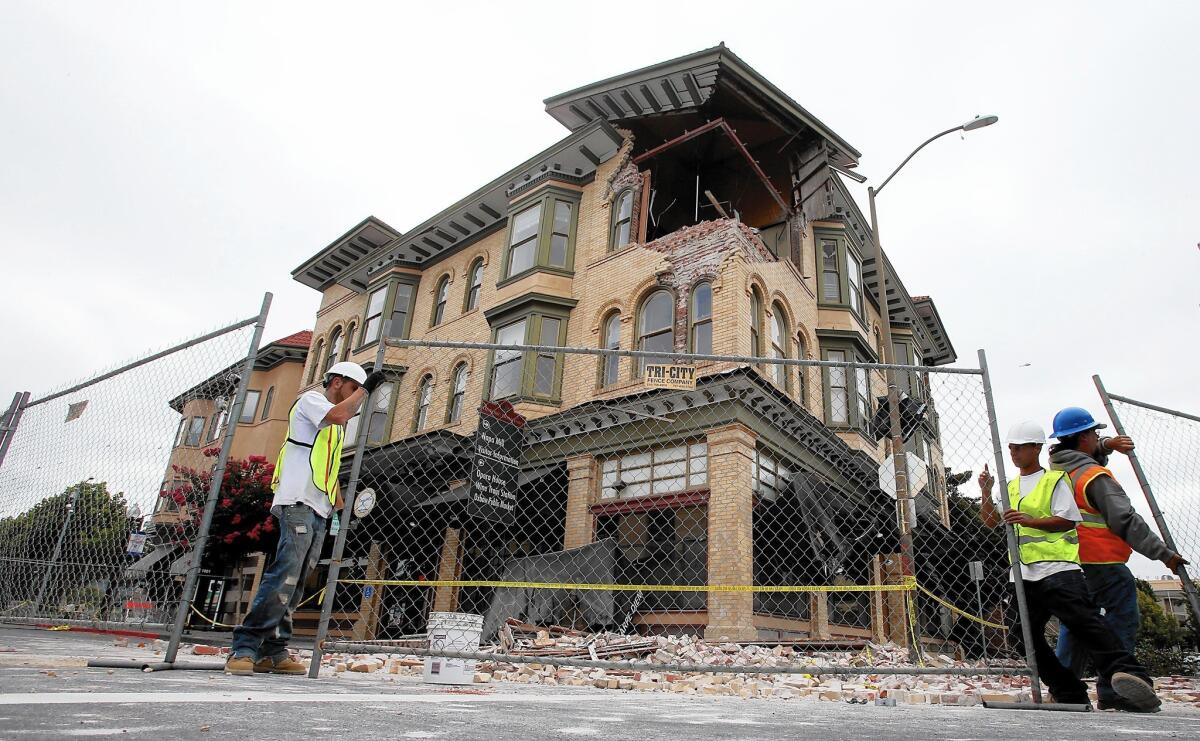Napa quake provides clues to which structures, and where, are at risk

Last year’s Napa earthquake, the largest to hit Northern California in a quarter-century, offers some lessons about how homes fare amid major shaking and what residents can do to make them more secure.
A new study analyzed the more than 1,500 buildings and houses damaged during the magnitude 6.0 earthquake and found that those built before 1950 sustained the most damage. The location of the homes also affected the amount of shaking and damage.
What does this mean for my home?
“This data should spur people to retrofit older homes,” said Jack Boatwright, a U.S. Geological Survey geophysicist and lead author of the study. There is an “enormous difference in vulnerability … between those homes that hadn’t been retrofitted and the homes that are bolted to the foundation and with strengthened cripple walls.”
The study analyzed buildings that had been red-tagged (severely damaged) and yellow-tagged (moderately damaged). Houses slid off their foundations, supporting walls snapped, brick chimneys collapsed, pipes and stairways broke, and masonry fell apart.
Looking at the cluster of red-tagged buildings, researchers saw there was a strong correspondence between the age of the buildings and the ones with the most damage. Many of the homes were built before 1950, based on an analysis of available maps and historic information. Homes built before the 1970s, when stronger building codes were introduced, were also more vulnerable to damage.
“The lack of damage in the newer neighborhoods of Napa may be the result of improvements to the building code enacted in 1975,” according to the study, which was published in Seismological Research Letters this month.
Does where my house is located matter?
The worst place to be is directly on top of an earthquake fault. During the Napa temblor, a buried fault ruptured up to the surface and tore a number of homes and foundations into two. Ground shaking is also intense for those built right next to a fault.
Boatwright’s study also found that many of the damaged homes were built on top of a “sedimentary basin” that may have amplified the ground shaking when the earthquake struck. Essentially, this is when a softer layer of sediment sits on top of a deeper, concave layer of bedrock. During an earthquake, the softer layer traps the seismic energy in the basin and causes stronger ground shaking that also lasts longer. The shape of the basin can affect how much the shaking gets amplified.
This massive basin sits below much of Napa Valley. Scientists are taking a closer look to better understand what this might mean for earthquakes in the region.
“We don’t have great seismological information on that basin,” Boatwright said. “We know it’s there, it deepens in the middle…. But we don’t know the depth of the basin, and we don’t know the shape of it.”
Are there other cities in California built on sedimentary basins?
“As it turns out, most areas that are urbanized, developed, where people live, tend to be on sedimentary basins,” said Robert Graves, a USGS research geophysicist based in Pasadena. These basins — formed by sediments washing down from the many mountains in California and filling the lower areas — tend to be relatively flat and easy to build on.
“I’m very interested in studying Napa, because it’s very analogous to what may occur here, during our next earthquake in Southern California,” Graves said.
Much of Los Angeles and a bit of northern Orange County lie on top of a sedimentary basin. The San Fernando Valley, for example, is basically a basin, Graves said. “It’s bounded by the hills and the mountains around it, but most of the developed, more urban area is sitting atop a fairly significant accumulation of sediment.”
Building codes generally account for these conditions and dictate what additional measures are needed to construct a home that can withstand the amplified shaking, Graves said. But older homes may not have factored in these considerations.
How do I make my home stronger?
A common weakness involves single-family homes built before 1979 with a handful of steps above the ground, where a crawl space a few feet tall is between the floor of the house and the concrete foundation.
The heavy house rests atop a flimsy wood-frame perimeter that is not bolted to the concrete foundation. So when an earthquake hits and the foundation moves, the wooden part of the house snaps off. The house can either topple or slide off of the foundation — like pulling the rug out from underneath the house.
The retrofit is generally simple: Use metal rods to attach the wooden house to the concrete foundation, and plywood “to add stiffness and strength to keep the house on its foundation,” said Janiele Maffei, a structural engineer and executive director of the California Residential Mitigation Program.
Fixing the damage after an earthquake could cost as much as $400,000. By contrast, the cost of a preventive retrofit is usually between $2,000 and $10,000, with an average price of $5,000, Maffei said.
More to Read
Sign up for Essential California
The most important California stories and recommendations in your inbox every morning.
You may occasionally receive promotional content from the Los Angeles Times.











